INSTITUT SUPERIEUR D'ANTHROPOLOGIE
INSTITUTE OF ANTHROPOLOGY
ONLINE COURSES / COURS A DISTANCE
DEBUT COURS : AVRIL 2023
REGISTER NOW
ISRAEL – 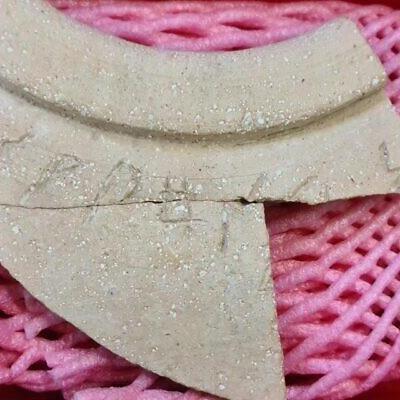 Jerusalem - After stumping epigraphers for over a decade, a mysterious First Temple-era inscription uncovered at the Ophel, a stone’s throw from Jerusalem’s Temple Mount, may finally have been deciphered. According to a new study by Dr. Daniel Vainstub, the seven-letter inscription etched on a large clay jar records one of the ingredients found in the incense mixture used in the Temple — perfumed gum resin or labdanum. According to readings of Exodus 30:34, aromatic labdanum (Cistus ladaniferus) is likely the second component of the Temple worship’s incense. Vainstub believes the inscription’s writing and language stem from the Kingdom of Sheba — over 2,000 kilometers (1,240 miles) away. This suggestion runs counter to the previous consensus opinion of a dozen top researchers who held it was written in the local script, Canaanite. However, in a new study published Monday in the Hebrew University’s Jerusalem Journal of Archaeology, Vainstub suggests the script is Ancient South Arabian (ASA) and records what appears to be a Sabaean-language word. During the First Temple period, the Sabaean language was used in what is today’s Yemen, where the Kingdom of Sheba once stood. If this is true, the Ophel inscription is the earliest Ancient South Arabian inscription found so far in the Land of Israel. Because the inscription was incised in wet clay that originated in Jerusalem, Vanstub hypothesizes that the scribe was a native speaker from the Kingdom of Sheba who was involved in supplying the incense spices. This, he contends, points to previously unconfirmed strong trade ties between the two kingdoms.
Jerusalem - After stumping epigraphers for over a decade, a mysterious First Temple-era inscription uncovered at the Ophel, a stone’s throw from Jerusalem’s Temple Mount, may finally have been deciphered. According to a new study by Dr. Daniel Vainstub, the seven-letter inscription etched on a large clay jar records one of the ingredients found in the incense mixture used in the Temple — perfumed gum resin or labdanum. According to readings of Exodus 30:34, aromatic labdanum (Cistus ladaniferus) is likely the second component of the Temple worship’s incense. Vainstub believes the inscription’s writing and language stem from the Kingdom of Sheba — over 2,000 kilometers (1,240 miles) away. This suggestion runs counter to the previous consensus opinion of a dozen top researchers who held it was written in the local script, Canaanite. However, in a new study published Monday in the Hebrew University’s Jerusalem Journal of Archaeology, Vainstub suggests the script is Ancient South Arabian (ASA) and records what appears to be a Sabaean-language word. During the First Temple period, the Sabaean language was used in what is today’s Yemen, where the Kingdom of Sheba once stood. If this is true, the Ophel inscription is the earliest Ancient South Arabian inscription found so far in the Land of Israel. Because the inscription was incised in wet clay that originated in Jerusalem, Vanstub hypothesizes that the scribe was a native speaker from the Kingdom of Sheba who was involved in supplying the incense spices. This, he contends, points to previously unconfirmed strong trade ties between the two kingdoms.
https://www.timesofisrael.com/newly-deciphered-inscription-gives-clue-to-biblical-queen-of-shebas-jerusalem-visit/
TCHEQUIE - South Bohemia - Part of a nail believed to have come from the so-called True Cross, discovered in a Premonstratensian monastery in South Bohemia in December 2020, will be displayed to the public for the first time. The six-inch-long piece of nail, believed to be part of the cross on which Jesus Christ was crucified, was discovered by archaeologists in a box in a cavity in the vault of the Milevsko monastery.
https://english.radio.cz/part-a-nail-true-cross-discovered-milevsko-go-display-8779496
CHINE - Zuojiang - According to a Xinhua report, snake bones have been found among mammal remains at a Neolithic site in the Zuojiang River Basin in southern China. The snake is estimated to have been more than 15 feet long and belonged to the species Python bivittatus, or Burmese python. Yang Qingping of the Guangxi Institute of Cultural Relic Protection and Archaeology said that most of the recovered bones bear signs of butchering and possible burn marks. The snake, he added, is thought to have been hunted for food.
https://www.archaeology.org/news/11323-230404-china-python-hunting
FRANCE –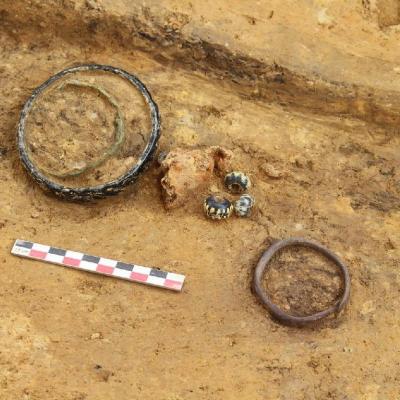 – La Chapelle-des-Fougeretz – Archaeologists from INRAP have been excavating a gallo-roman necropolis and sanctuary . The site was first identified in 1984, leading to a survey in 2018 to define the excavation area. Since then, INRAP have conducted an ongoing excavation over a period of eight months in preparation for a new housing estate. Excavations of the sanctuary suggest that it was dedicated to Mars, the Roman god of war, based on a dozen swords and spear heads deposited as ritual offerings, and a small statuette of Mars in situ. The team also found the remains of furniture, billhooks, several brooches, numerous items of weaponry, and a selection of Gallic and Roman coins. The sanctuary dates from the early Roman period and was abandoned during the 4th century AD. Surrounding the sanctuary are several dwellings built from earth and wood that contain domestic goods and ceramic vessels. The team also uncovered a small Gallo-Roman necropolis consisting of 40 burials dating from the Late Roman period until the 5th century AD. The necropolis has yielded a large quantity of funerary objects, including silver bracelets, pins and belt buckles, glass beads, ceramics, a pearl necklace, and the traces of shoes left by the studs that still survive. Excavations of one of the burials was found to contain a dagger and parts of a horse harness, with pieces of iron and bronze that were used to decorate the bridle and reins. Following the excavation phase, the objects have been removed for preservation and further analysis. Several objects have been scanned in 3D to understand the nature and purpose, in particular, objects that have been heavily corroded.
– La Chapelle-des-Fougeretz – Archaeologists from INRAP have been excavating a gallo-roman necropolis and sanctuary . The site was first identified in 1984, leading to a survey in 2018 to define the excavation area. Since then, INRAP have conducted an ongoing excavation over a period of eight months in preparation for a new housing estate. Excavations of the sanctuary suggest that it was dedicated to Mars, the Roman god of war, based on a dozen swords and spear heads deposited as ritual offerings, and a small statuette of Mars in situ. The team also found the remains of furniture, billhooks, several brooches, numerous items of weaponry, and a selection of Gallic and Roman coins. The sanctuary dates from the early Roman period and was abandoned during the 4th century AD. Surrounding the sanctuary are several dwellings built from earth and wood that contain domestic goods and ceramic vessels. The team also uncovered a small Gallo-Roman necropolis consisting of 40 burials dating from the Late Roman period until the 5th century AD. The necropolis has yielded a large quantity of funerary objects, including silver bracelets, pins and belt buckles, glass beads, ceramics, a pearl necklace, and the traces of shoes left by the studs that still survive. Excavations of one of the burials was found to contain a dagger and parts of a horse harness, with pieces of iron and bronze that were used to decorate the bridle and reins. Following the excavation phase, the objects have been removed for preservation and further analysis. Several objects have been scanned in 3D to understand the nature and purpose, in particular, objects that have been heavily corroded.
https://www.heritagedaily.com/2023/04/new-discoveries-from-roman-site-in-north-western-france/146769
BELGIQUE – Habay-la-Neuve - Nos ancêtres les Celtes représentent une énigme pour les archéologues. On en connaît certaines sépultures, tombes à char ou tombelles. On sait qu’ils se fortifiaient derrière des éperons barrés, mais on a très peu ou pas de traces de leur habitat… C’est ce qui rend exceptionnelle la découverte réalisée à Habay-la-Neuve dans une petite exploitation agricole gallo-romaine des premier et deuxième siècles. On y a trouvé des trous de poteaux d’une construction antérieure qui prouve que cet emplacement était déjà habité à l’époque de la Tène, avant la conquête romaine de nos régions par Jules César. Une trace d’habitat exceptionnelle pour la Wallonie et unique en province de Luxembourg ! Cette implantation gallo-romaine avait été repérée dans les années 80 par Guy Fairon, adepte de prospection archéologique par photo aérienne. De rapides sondages avaient confirmé l’existence d’un bâtiment. Les fouilles se sont étalées en discontinu sur plusieurs années. Et tout dernièrement, les traces d’un puits sont apparues. Avec beaucoup de précautions, les madriers et les planches qui constituaient le fond de ce puits ont été prélevées. Deux de ces madriers portent des traces d’assemblages dites « à traits de Jupiter » ce qui tend à prouver le réemploi car ces découpes étaient profondément enfoncées dans le sol. Une fois lavées, poutres et planches devraient laisser voir des traces d’outils qui permettront peut-être d’affiner nos connaissances sur les techniques employées à une époque que la dendrochronologie devrait permettre de situer avec précision.
VIDEO = https://www.tvlux.be/video/info/un-puits-romain-conserve-et-les-premieres-traces-d-un-habitat-celtique-a-habay_42579.html
ANGLETERRE – 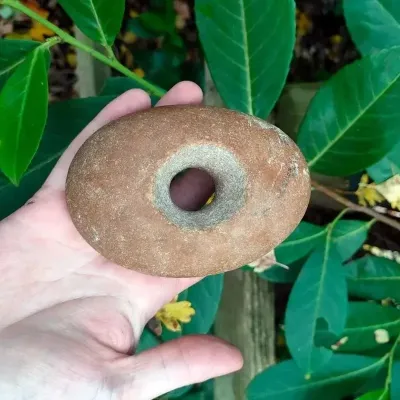 Buckingham - Archaeologists discovered an attractive Mesolithic stone mace head while excavation of a site near Buckingham. The quartzite pebble mace head discovered at the site is roughly oval in plan (105mm x 74mm x 40mm) with a central hourglass perforation (approximately 35mm-20mm in diameter). Both ends of the mace head exhibit light impact damage, suggestive of use as a percussive tool. The object was hafted, as evidenced by minor wear at the narrow point of the central perforation. Small chip marks around the circumference of the central perforation suggest that it was made using a technique known as pecking, rather than having been drilled. Mesolithic hunter-gatherer activity is thought to have been concentrated in resource-rich areas such as woodland and along watercourses, with recorded sites mostly located on dryer, rising ground. The site was in such a location, on a tributary of the River Great Ouse. The mace head was found in a post-medieval quarry fill that had cut off a curving ditch. With the mace head coming from a truncated internal deposit, it’s possible that this ditch was once part of a prehistoric ring ditch. Using aerial photography, two more ring ditches, possibly representing Bronze Age round barrows, have been identified nearby, and two more ring ditches, as well as Bronze Age cremation burials, are known from the surrounding area.
Buckingham - Archaeologists discovered an attractive Mesolithic stone mace head while excavation of a site near Buckingham. The quartzite pebble mace head discovered at the site is roughly oval in plan (105mm x 74mm x 40mm) with a central hourglass perforation (approximately 35mm-20mm in diameter). Both ends of the mace head exhibit light impact damage, suggestive of use as a percussive tool. The object was hafted, as evidenced by minor wear at the narrow point of the central perforation. Small chip marks around the circumference of the central perforation suggest that it was made using a technique known as pecking, rather than having been drilled. Mesolithic hunter-gatherer activity is thought to have been concentrated in resource-rich areas such as woodland and along watercourses, with recorded sites mostly located on dryer, rising ground. The site was in such a location, on a tributary of the River Great Ouse. The mace head was found in a post-medieval quarry fill that had cut off a curving ditch. With the mace head coming from a truncated internal deposit, it’s possible that this ditch was once part of a prehistoric ring ditch. Using aerial photography, two more ring ditches, possibly representing Bronze Age round barrows, have been identified nearby, and two more ring ditches, as well as Bronze Age cremation burials, are known from the surrounding area.
https://arkeonews.net/mesolithic-stone-mace-head-found-during-excavation-of-a-site-near-buckingham/
CHINE – 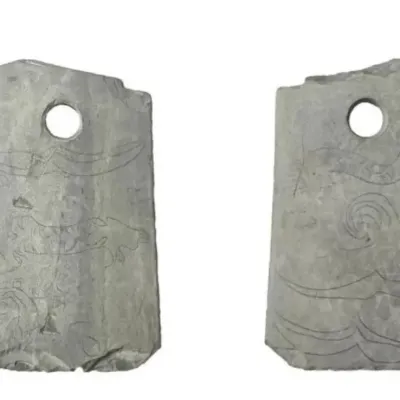
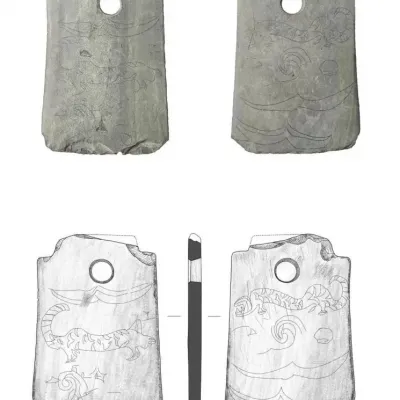 Wuxi - Archaeologists discovered an extremely rare stone relic, an axe-shaped weapon used for rituals in ancient China, engraved with a tiger pattern. The extremely rare stone relic was found in Wuxi City in eastern China‘s Jiangsu Province. The relic dates back some 4,500 years, during the Liangzhu Culture period. Archaeologists date the influential Liangzhu culture from 3300 to 2250 BCE. Located south of the Yangzi River, the enormous settlement has been named Liangzhu after the modern site where evidence of the culture was first discovered in the early twentieth century. Archaeologists discovered 329 stone tools at the Dinggeng archaeological site in Wuxi City recently. In addition, the team discovered 73 stone and bone arrowheads, as well as numerous ceramic and jade artifacts. A 4,500-year-old stone relic carved on both sides with depictions of tigers and patterns of clouds and birds surprised archaeologists, according to a statement at the Dinggeng Relics Site archaeological site on Saturday. 16 archaeologists from home and abroad said it was the first time they had seen such a tiger-patterned stone relic, which they believed to be a symbol of power. Liu Baoshan, head of the Wuxi institute of cultural relics and archaeology, said these patterns had single, relatively smooth lines.
Wuxi - Archaeologists discovered an extremely rare stone relic, an axe-shaped weapon used for rituals in ancient China, engraved with a tiger pattern. The extremely rare stone relic was found in Wuxi City in eastern China‘s Jiangsu Province. The relic dates back some 4,500 years, during the Liangzhu Culture period. Archaeologists date the influential Liangzhu culture from 3300 to 2250 BCE. Located south of the Yangzi River, the enormous settlement has been named Liangzhu after the modern site where evidence of the culture was first discovered in the early twentieth century. Archaeologists discovered 329 stone tools at the Dinggeng archaeological site in Wuxi City recently. In addition, the team discovered 73 stone and bone arrowheads, as well as numerous ceramic and jade artifacts. A 4,500-year-old stone relic carved on both sides with depictions of tigers and patterns of clouds and birds surprised archaeologists, according to a statement at the Dinggeng Relics Site archaeological site on Saturday. 16 archaeologists from home and abroad said it was the first time they had seen such a tiger-patterned stone relic, which they believed to be a symbol of power. Liu Baoshan, head of the Wuxi institute of cultural relics and archaeology, said these patterns had single, relatively smooth lines.
https://arkeonews.net/4500-year-old-tiger-patterned-ritual-weapon-uncover-in-east-china/
EGYPTE –  Nazlet Khater 2 - Archaeologist Moacir Elias Santos of the Ciro Flamarion Cardoso Archaeology Museum and his colleagues have created a 3-D digital approximation of the face of a man who lived in Egypt some 30,000 years ago. Analysis of the remains, which were uncovered in Egypt’s Nile Valley at a site known as Nazlet Khater 2 in 1980, suggests the man stood about five feet, three inches tall and was between the ages of 17 and 29 at the time of death. A stone ax was also recovered from the grave. “The skull, in general terms, has a modern structure, but part of it has archaic elements, such as the jaw, which is much more robust than that of modern men,” said team member and graphics expert Cícero Moraes. The researchers used photogrammetry to combine images of the skull and produce a black-and-white depiction of the man with his eyes closed, and an artistic rendering showing him with hair and a beard.
Nazlet Khater 2 - Archaeologist Moacir Elias Santos of the Ciro Flamarion Cardoso Archaeology Museum and his colleagues have created a 3-D digital approximation of the face of a man who lived in Egypt some 30,000 years ago. Analysis of the remains, which were uncovered in Egypt’s Nile Valley at a site known as Nazlet Khater 2 in 1980, suggests the man stood about five feet, three inches tall and was between the ages of 17 and 29 at the time of death. A stone ax was also recovered from the grave. “The skull, in general terms, has a modern structure, but part of it has archaic elements, such as the jaw, which is much more robust than that of modern men,” said team member and graphics expert Cícero Moraes. The researchers used photogrammetry to combine images of the skull and produce a black-and-white depiction of the man with his eyes closed, and an artistic rendering showing him with hair and a beard.
https://www.archaeology.org/news/11324-230404-egyptian-digital-image
CHINE – 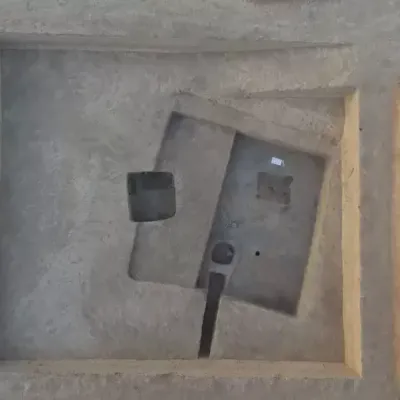 Xinghuacun - Archaeologists have unearthed the foundations of two houses dating back 5,500 years in north China's Shanxi Province. This was reported by The Xinhua News Agency. The house foundations were found at an archaeological site in Xinghuacun Township in Fenyang City and traced back to the middle period of the Yangshao culture, according to the provincial institute of cultural relics and archaeology. The Yangshao culture, dating back 5,000 to 7,000 years, was a Neolithic culture that originated along the middle reaches of the Yellow River. The two house foundations, both halfway underground, were found in varying sizes. The larger site covers about 39 square meters, and the smaller one covers around 30 square meters.Fragments of various artifacts, including millstone, sharp-bottomed bottles, and painted pottery pots, were unearthed at the larger site. In addition, the smaller site shows signs of burning. "The discovery of two house foundations is of great significance to the study of the structure, layout, construction technology, and function of houses in the middle period of the Yangshao culture", – said Wang Pujun, the director of the archaeological project.
Xinghuacun - Archaeologists have unearthed the foundations of two houses dating back 5,500 years in north China's Shanxi Province. This was reported by The Xinhua News Agency. The house foundations were found at an archaeological site in Xinghuacun Township in Fenyang City and traced back to the middle period of the Yangshao culture, according to the provincial institute of cultural relics and archaeology. The Yangshao culture, dating back 5,000 to 7,000 years, was a Neolithic culture that originated along the middle reaches of the Yellow River. The two house foundations, both halfway underground, were found in varying sizes. The larger site covers about 39 square meters, and the smaller one covers around 30 square meters.Fragments of various artifacts, including millstone, sharp-bottomed bottles, and painted pottery pots, were unearthed at the larger site. In addition, the smaller site shows signs of burning. "The discovery of two house foundations is of great significance to the study of the structure, layout, construction technology, and function of houses in the middle period of the Yangshao culture", – said Wang Pujun, the director of the archaeological project.
https://ukranews.com/en/news/922577-house-remains-dating-back-5-500-yrs-found-in-china-s-shanxi